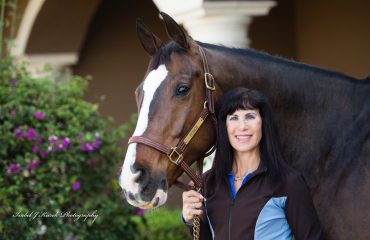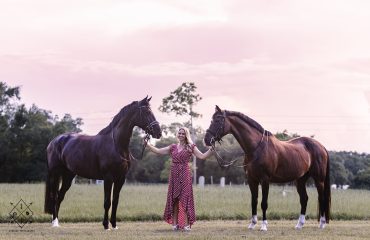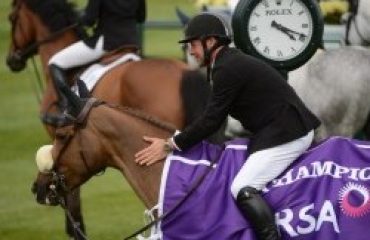 A sought-after trainer and clinician, American Olympic dressage rider Christine Traurig was born and raised on her parents’ breeding farm near Verden, Germany. She rode and trained for the Hanoverian Elite Sales in Verden before moving to the United States in 1982, where she assisted Bernie Traurig in operating an import and sales business of dressage horses and jumpers. Christine and Bernie were instrumental in establishing the Saudi Arabian Equestrian Team and Federation. With her equine partner Etienne, Christine was a member of the 2000 Sydney Olympic bronze medal team. She now operates Christine Traurig Dressage Stables, Inc. in Rancho Santa Fe, California. She conducts clinics and symposiums all over the U.S. and in 2015, was appointed to the position of USEF National Coach for Young Dressage Horses. Do you have a question you want Christine to answer? Send questions to editor@sidelinesnews.com.
A sought-after trainer and clinician, American Olympic dressage rider Christine Traurig was born and raised on her parents’ breeding farm near Verden, Germany. She rode and trained for the Hanoverian Elite Sales in Verden before moving to the United States in 1982, where she assisted Bernie Traurig in operating an import and sales business of dressage horses and jumpers. Christine and Bernie were instrumental in establishing the Saudi Arabian Equestrian Team and Federation. With her equine partner Etienne, Christine was a member of the 2000 Sydney Olympic bronze medal team. She now operates Christine Traurig Dressage Stables, Inc. in Rancho Santa Fe, California. She conducts clinics and symposiums all over the U.S. and in 2015, was appointed to the position of USEF National Coach for Young Dressage Horses. Do you have a question you want Christine to answer? Send questions to editor@sidelinesnews.com.
What do you tell your students to help them with their position?
I always tell my students: Think tall from the waist up, long from the waist down with your heels down and weight in the stirrup, with a straight line from the elbows to the horse’s mouth and thumbs up. Keep your chin up — the way you want your horse’s poll up!
Who’s your favorite grand prix horse, past or present, to watch compete and why?
One of my all-time favorites in the past was Corlandus, ridden by Margit Otto Crepin. He had such power and strong character yet such grace and lightness. And how could I not mention Totilas? I’ll never forget his piaffe-passage work, the ease of it, like there was nothing to it. The partnership between him and Edward Gal was obvious and then he leaves the packed stadium at Aachen on the buckle looking at the crowd! Just like Audrey Hepburn said of Michael Jackson: “You just can’t stop watching him.” And in the present I think of Valegro as an example of classical dressage, which, when I thought it doesn’t get any better, it got even better and more brilliant. Every decade, every few years, the sport gives us idols who we admire because they get under our skin, whether we’re professionals, amateurs, owners, breeders, juniors/young riders, little kids or just fans of the sport and horse. This is good for the sport and the popularity of it.
What do you look for in a young dressage prospect?
I look for three good gaits, of which the canter is very important because it’s the hardest to improve. Conformation: My father, who was a breeder, always told me, “You look at a horse from the bottom up. The foundation is what you build on, the feet, the legs, then upward.” Temperament is as important as talent. Talent is always compromised if the temperament (willingness to work with the rider, eagerness to please) is difficult.
How important is straightness in dressage, and how do you recommend practicing it?
Straightness is a prerequisite for collection in accordance with the scale of training. Straightness is the alignment of the forehand and hind end of the horse. Developing it starts with bending aids on bent lines (circles), suppling the stiff side and aligning the hollow or crooked side. When a horse travels on two tracks on a circle, meaning the hind feet meet the prints of the front feet, it’s “aligned” and straight. Straightness is further cultivated through shoulder fore and shoulder in.
What do you think jumper riders and dressage riders could learn from each other?
After years of having ridden jumpers on the flat, I’ve come to appreciate the feeling of a gallop in a two-point. Rarely ever do you see a dressage rider look for that opportunity. It’s good for the horses to move free and forward along a track or in a big grass field outside of the confinement of the dressage arena. Control is the ability to go forward without the feeling you lose control. As for the jumper riders, I think they should not look at dressage as what we ride from letter to letter, but how we develop the physical aspect of pushing and carrying, adjustability and prompt responses in the horses by gymnasticizing the body. A flexible, strong body is mobile and powerful.
How do you teach riders to lighten their seat?
I personally don’t believe in riding from a heavy seat. What does that even mean? That a rider puts all their body weight into the seat and presses it into the horses back? That alone is a concept that doesn’t apply to the modern breed of dressage horses. Going back, here in the U.S., the sport of show jumping was based on riding Thoroughbreds. Sensitive horses, sensitive backs and therefore ridden in what made the U.S. show jumpers famous for their style of riding: the forward seat (light seat/two point). If I had to teach a dressage rider to lighten the seat, I’d teach them the two-point so the rider feels that more weight in the stirrup means less weight on the seat bones and that eventually they learn how to adjust the ratio between the two.
What do you think is an often overlooked but important principle of good riding?
Today the rules and regulations of the sport are giving us many guidelines and principles to train and compete by. This is a good thing. Are there at times aspects which are overshadowed by the brilliance of a moment? Yes! And that’s in the nature of the sport too. One thing that I’m a stickler on is connection: the relationship of the hind leg to the bit through a supple and elastic top line. At times we see a light contact and expressive front legs without relating hind legs. Connection encompasses the harmonious acceptance of leg aids in relation to contact with the horse working through its body.













